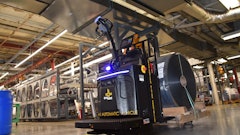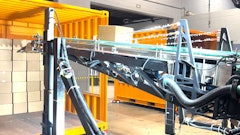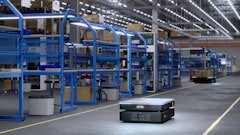Santa Clara, CA — June 17, 2003 — Nearly three-quarters of the companies in a new survey are still using manual techniques to locate and track their physical assets, and 100 percent of the companies polled said that their asset management data is inaccurate due to manual processes.
The survey, conducted by WhereNet, a provider of wireless location and communications solutions for managing mobile resources, encompassed some 50 operations managers, engineers and information technology executives across a variety of industries, and it revealed several shortcomings of current asset management techniques, the associated costs of those techniques and a "wish list" for solutions to manage critical supply chain assets.
More than 70 percent of the survey respondents indicated that their companies still use manual labor — either through physical searches or barcode scanning — to locate and track inventory or high-value assets, and all the respondents indicated that their asset management data is inaccurate because of this manual process. In addition, 64 percent of the respondents reported that their companies are forced to conduct manual searches at least once a day to locate assets or inventory.
"These survey results further demonstrate the need for total asset visibility within end-user environments," said Michael Liard, a senior analyst with Venture Development Corp. "Enterprises of all sizes are challenged with the 'black hole' syndrome in their daily operations; if they had real-time data about the location and status of all their assets, their overall operation would be, by orders of magnitude, much more efficient."
Liard said that while passive radio frequency identification (RFID) technology has made strides in providing improved location information, most enterprise systems and end users still don't have access to real-time data about their high-value mobile assets. "Companies are increasingly requiring wireless, constant connectivity solutions ... that drive new applications to transform their business," Liard said.
The survey highlighted a host of issues with current asset management methods, including significant labor costs and expenses incurred due to a lack of real-time information about inventory and assets in the supply chain.
One hundred percent of respondents admitted that their data capture information is inaccurate due to human input error, improper scans or missed scans. In addition, all the respondents reported that the latency associated with current inventory systems results in the incorrect location of inventory, often because by the time the asset or inventory is located, scanned and downloaded into an inventory management or enterprise system, its "original" status has changed.
In other results, 64 percent of respondents reported that operations personnel perform at least one search per day for inventory or assets, with 27 percent reporting more than 10 searches per day, and 47 percent of respondents indicated that each search to locate an item can take up to one hour to complete.
These manual searches can become costly: 33 percent of respondents spend more than $50,000 annually in labor alone trying to locate lost assets.
Meanwhile, nearly three-quarters (73 percent) of the survey respondents agreed that the ideal asset/inventory tracking system would enable their company to have real-time visibility of all critical assets/inventory in yards, distribution centers, ports, intermodal facilities and other locations.
These respondents believe such a system would help them to reduce the amount of inventory in the supply chain, thereby decreasing losses due to overstocking, and also to trim labor costs associated with managing inventory, transportation assets and manual inventory audits.
Overall, the results suggest that operations and IT managers and executives believe they could significantly streamline their operations if they had real-time connectivity to the assets that they are tasked with managing on a daily basis, but latency and human input error are causing current data collection processes and systems to be bottlenecks for enterprises trying to reduce inventory, increase throughput and optimize their supply chains.
"The survey findings echo the feedback that we receive from the field every day: enterprises are looking for solutions to better manage their resources and to cut operational costs, reduce inventory and automate manual processes," said Matt Armanino, vice president of business development for WhereNet. "From distribution centers to intermodal facilities to automotive factories, workers and information systems are fundamentally disconnected from the mobile assets that they are trying to manage."
Consultancy Accenture recently released the results of a study suggesting that manufacturers and retailers will begin broadly adopting RFID and related technologies to tag and track inventory and equipment by 2005, potentially saving billions of dollars each year. See the June 16, 2003, iSourceonline story "Broader RFID Adoption Seen by 2005."
For more information on the use of RFID solutions in the supply chain, see "Needle in a Supply Chain Haystack," the Net Best Thing column in the January 2002 issue of iSource Business.


























